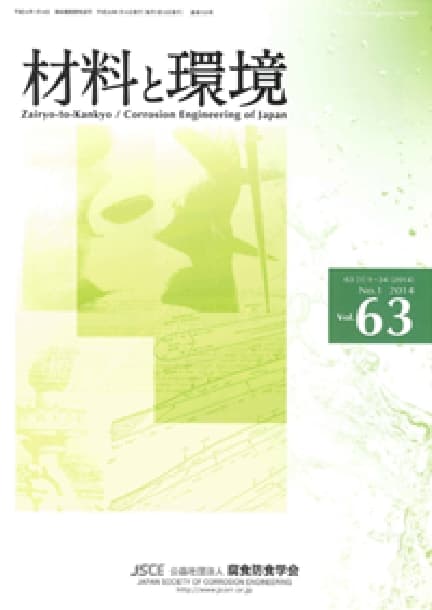材料と環境 Vol. 69 (2020), No. 2
Backnumber
-
Vol. 74 (2025)
-
Vol. 73 (2024)
-
Vol. 72 (2023)
-
Vol. 71 (2022)
-
Vol. 70 (2021)
-
Vol. 69 (2020)
-
Vol. 68 (2019)
-
Vol. 67 (2018)
-
Vol. 66 (2017)
-
Vol. 65 (2016)
-
Vol. 64 (2015)
-
Vol. 63 (2014)
-
Vol. 62 (2013)
-
Vol. 61 (2012)
-
Vol. 60 (2011)
-
Vol. 59 (2010)
-
Vol. 58 (2009)
-
Vol. 57 (2008)
-
Vol. 56 (2007)
-
Vol. 55 (2006)
-
Vol. 54 (2005)
-
Vol. 53 (2004)
-
Vol. 52 (2003)
-
Vol. 51 (2002)
-
Vol. 50 (2001)
-
Vol. 49 (2000)
-
Vol. 48 (1999)
-
Vol. 47 (1998)
-
Vol. 46 (1997)
-
Vol. 45 (1996)
-
Vol. 44 (1995)
-
Vol. 43 (1994)
-
Vol. 42 (1993)
-
Vol. 41 (1992)
-
Vol. 40 (1991)
キーワードランキング
07 Dec. (Last 30 Days)
材料と環境 Vol. 69 (2020), No. 2
半導体化学センサで測定したステンレス鋼のすきま内pHとすきま腐食挙動との関係
野瀬 清美, 梶村 治彦, 宮本 浩一郎, 吉信 達夫
pp. 40-48
DOI:
10.3323/jcorr.69.40抄録
In order to clarify the relationship between crevice corrosion behavior of SUS304 and the pH in crevice(pHc), simultaneous measurement of pH in crevice by semiconductor chemical sensor at potentiostatic polarization.The pH measured by the sensor is not influenced by the metal ion and shows the value reflecting[ H+] and γH+.When crevice corrosion is always progressing by potentiostatic polarization, among the metal ions dissolved in the crevice, mainly in the hydrolysis reaction of Cr3+ or formation of chloride complex ions, the entire crevice part becomes extremely low pH environment with pHc<0.0.On the other hand, when polarization by two-step potentiostatic polarization, the amount of metal dissolved in the crevice decreases depending on the second potential(E2), and finally, eventually leading to re-passivation.In the case of this study, the re-passivation pH after crevice corrosion progression was 2.5 to 3, and the repassivation potential was about 80 mV, which gave high engineering significance.
SUS304鋼の不働態化pHにおよぼす塩化物イオンと溶存酸素濃度の影響
長岡 彬, 野瀬 清美, 松橋 亮, 松岡 和巳, 梶村 治彦
pp. 49-57
DOI:
10.3323/jcorr.69.49抄録
When crevice corrosion of stainless steel occurs and progresses, the proton and the chloride ion concentration is high and there is no dissolved oxygen in the crevice. On the other hand, when crevice corrosion of stainless steel stops, the proton and the chloride ion diffuses out of the crevice and dissolved oxygen penetrates the inside of the crevice. In this case, the state of the stainless steel changes from active state to passive state.Since it is important to know the passivation behavior of the stainless steel, we invest the effect of chloride ion and dissolved oxygen concentration on passivation pH of SUS304 stainless steel.The passivation pH of SUS304 steel increased with increasing chloride ion concentration and decreasing dissolved oxygen. When cathodic current density exceeds ICRIT, passivation occurs.Therefore, It is assumed that the rise of ICRIT and the decrease of cathodic current density of the proton reduction with the rise of chloride ion concentration and the decrease of cathodic current density of the oxygen reduction with the decrease of dissolved oxygen concentration contributes to increasing passivation pH.
論文アクセスランキング
07 Dec. (Last 30 Days)
-
Perspectives on the Promising Pathways to Zero Carbon Emissions in the Steel Industry toward 2050
ISIJ International Vol.65(2025), No.2
-
Factors Influencing the Bonding Phase Structure of Iron Ore Sinters
ISIJ International Vol.43(2003), No.9
-
-
大気腐食環境下における1700 MPa級調質ボルトの遅れ破壊機構
鉄と鋼 早期公開
-
Progress of Strip Casting Technology for Steel; Historical Developments
ISIJ International Vol.52(2012), No.12
-
Research Progress on Optimal Blending of Iron Ore Powders for Sintering
ISIJ International Vol.65(2025), No.12
-
-
Microstructures and Reduction Properties of High CaO Concentration Sintered Ore
ISIJ International 早期公開
-
Influence of Antimony on the Oxidation Characteristics of 65Mn Steel
ISIJ International 早期公開
-
電解水素チャージによるチオシアン酸アンモニウムの分解機構
材料と環境 Vol.74(2025), No.2
この機能はログイン後に利用できます。
下のボタンをクリックしてください。










